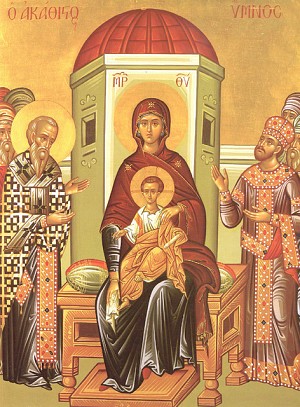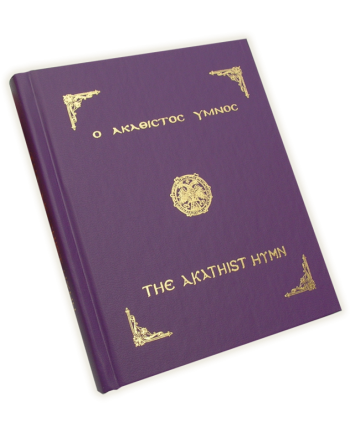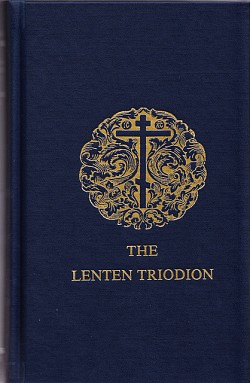GREAT LENT QUICK LINKS:
Great Lent I Pre-Lenten Period I Lenten Worship I On Fasting I On Confession
The weekday services of Great Lent are characterized by special lenten melodies of a penitential character.
The royal gates to the altar area remain closed to signify man’s separation through sin from the Kingdom of God. The church vesting is of a somber color, usually purple. The daily troparia are also of an intercessory character, entreating God through his saints to have mercy on us sinners.
At the Matins the long Alleluia replaces the psalm: God is the Lord... The Psalmody is increased. The hymnology refers to the lenten effort. Scripture readings from Genesis and Proverbs are added to Vespers, and the Prophecy of Isaiah to the Sixth Hour. Each of these books is read nearly in its entirety during the lenten period. Epistle and gospel readings are absent because there are no Divine Liturgies.
At all of the lenten services the Prayer of St Ephraim of Syria is read. It supplicates God for those virtues especially necessary to the Christian life.
O Lord and Master of my life: take from me the spirit of sloth, faint-heartedness, lust of power and idle talk.
But grant rather the spirit of chastity, humility, patience and love to Thy servant.
Yea, O Lord and King, grant me to see my own errors and not to judge my brother, for blessed art Thou unto ages of ages. Amen.
The first Saturday of Great Lent is dedicated to the memory of St Theodore of Tyre. The second, third, and fourth Saturdays are called Memorial Saturdays since they are dedicated to the remembrance of the dead.
On Memorial Saturdays the liturgical hymns pray universally for all of the departed, and the Matins for the dead, popularly called the parastasis or panikhida, is served with specific mention of the deceased by name. Litanies and prayers are also added to the Divine Liturgy at which the scripture readings refer to the dead and their salvation by Christ.
Saturday, even during the non-lenten season, is the Church’s day for remembering the dead. This is so because Saturday, the Sabbath Day, stands as the day which God blessed for life in this world. Because of sin, however, this day now symbolizes all of earthly life as naturally fulfilled in death. Even Christ the Lord lay dead on the Sabbath Day, “resting from all of his works” and “trampling down death by death.” Thus, in the New Testament Church of Christ, Saturday becomes the proper day for remembering the dead and for offering prayers for their eternal salvation.
From The Orthodox Faith, by Fr Thomas Hopko (OCA Website).
As we already have seen, the eucharistic Divine Liturgy is not celebrated in the Orthodox Church on lenten weekdays.
In order for the faithful to sustain their lenten effort by participation in Holy Communion, the Liturgy of the Presanctified Gifts is served. The service is an ancient one in the Orthodox Church. We officially hear about it in the canons of the seventh century, which obviously indicates its development at a much earlier date.
The Liturgy of the Presanctified Gifts is an evening service. It is the solemn lenten Vespers with the administration of Holy Communion added to it. There is no consecration of the eucharistic gifts at the presanctified liturgy. Holy Communion is given from the eucharistic gifts sanctified on the previous Sunday at the celebration of the Divine Liturgy, unless, of course, the feast of the Annunciation should intervene; hence its name of “presanctified.”
The Liturgy of the Presanctified Gifts is served on Wednesday and Friday evenings, although some churches may celebrate it only on one of these days. It comes in the evening after a day of spiritual preparation and total abstinence. The faithful who are unable to make the effort of total fasting because of weakness or work, however, normally eat a light lenten meal in the early morning.
During the psalms of Vespers, the presanctified gifts are prepared for communion. They are transferred from the altar table where they have been reserved since the Divine Liturgy, and are placed on the table of oblation. After the evening hymn, the Old Testamental scriptures of Genesis and Proverbs are read, between which the celebrant blesses the kneeling congregation with a lighted candle and the words: “The Light of Christ illumines all,” indicating that all wisdom is given by Christ in the Church through the scriptures and sacraments. This blessing was originally directed primarily to the catechumens—those preparing to be baptized on Easter—who attended the service only to the time of the communion of the faithful.
After the readings, the evening Psalm 141 is solemnly sung once again with the offering of incense. Then, after the litanies of intercession and those at which the catechumens were dismissed in former days, the presanctified eucharistic gifts are brought to the altar in a solemn, silent procession. The song of the entrance calls the faithful to communion:
Now the heavenly powers (i.e., the angels) do minister invisibly with us. For behold the King of Glory enters. Behold the mystical sacrifice, all fulfilled, is ushered in.
Let us with faith and love draw near that we may be partakers of everlasting life.
Alleluia. Alleluia. Alleluia.
The Liturgy of the Presanctified Gifts is traditionally considered to be the work of the sixth-century pope, Saint Gregory of Rome. The present service, however, is obviously the inspired liturgical creation of Christian Byzantium
The Akathist Hymn is a profound, devotional poem, which sings the praises of the Holy Mother and Ever-Virgin Mary.
It is one of the most beloved services in the Orthodox Church. It was composed in the imperial city of Constantinople, "the city of the Virgin," by St. Romanos the Melodist, who reposed in the year 556. The Akathist Hymn has proven so popular in the liturgical life of the Church that many other hymns have been written following its format. These include Akathists to Our Lord Jesus Christ, to the Cross, and to many Saints.
The word "akathistos" means "not sitting," i.e., standing; normally all participants stand while it is being prayed. The hymn is comprised of 24 stanzas, arranged in an acrostic following the Greek alphabet. The stanzas alternate between long and short. Each short stanza is written in prose and ends with the singing of "Alleluia." Each longer stanza ends with the refrain: "Rejoice, O Bride Unwedded."
The first part of the hymn is about the Annunciation to the Virgin Mary by the Angel. It describes Mary’s surprise at the news, her visit to her mother and Joseph’s doubts as to her innocence. The second part is about the birth of Christ, the worship of the Shepherds and Magi, the flight to Egypt and the visit to Saint Simeon in the Temple. In the third part the hymn directs our attention to the renewal of the world by Christ’s coming, and the amazement of the Angels and the wise men at the sight of the Incarnation of God’s Son. The fourth and the last part is once more a lyric and rhetorical appraisal of Virgin Mary, whom the poet adorns with the most beautiful of adjectives asking her to accept his poetical offering and to intercede for the salvation of human race from the earthly sin.
Hymns of the Akathist
Troparion - Tone 8
Kontakion - Tone 8
Victorious leader of triumphant hosts, we your servants, delivered from evil, sing our grateful thanks to you, Theotokos! As you possess invincible might set us free from every calamity, so that we may sing: Rejoice, unwedded Bride!
Theotokion - Tone 8
Seeing the beauty of your Virginity, and how resplendently shone forth your chastity, amazed was Gabriel who cried to you thus, O Theotokos: What shall I present to you as a worthy encomium? What shall I address you as? At a loss and perplexed am I. As ordered, therefore, thus do I shout to you: Rejoice, O Maiden who are full of grace!-
The meticulously published book of The Service of the Akathist Hymn, by Holy Transfiguration Monastery in Boston, is currently out of print. You may be able to find a copy on ebay.
However, there is a handsome Akathist Hymn volume edited by the late Fr George Papadeas, who also produced the venerable and much loved Holy Week Service Book. Both of these are attractive, harcover books, with Greek text on the left, and English on the right, with directives in red and the text in black ink. Follow the links to learn more and to order.
We offer the following links belopw as an online alternative.
The Service of The Akathist Hymn
for the Fridays of Great Lent
The Akathist Canon and Hymn is laid out such that it can be used in a service with a priest or as a Reader Services. The texts of Small Compline are available both for use with a Priest, and as a Reader Service. This is presented in hopes that those who either belong to parishes which have no Friday evening services scheduled during Great Lent, or who are isolated from a parish, will find this beautiful service helpful in their Lenten struggles.
The Order of Service
On the first four Fridays of Lent, at Small Compline, immediately after “It is truly meet…” we chant the Akathist Canon followed by the Stasis which corresponds to the week:
- Akathist Canon
- First Stasis of the Akathist (first Friday)
- Second Stasis of the Akathists (Second Friday)
- Third Stasis of the Akathists (Third Friday)
- Fourth Stasis of the Akathist (Fourth Friday)
On the fifth Friday of Great Lent, according to Greek practice, the Akathist Canon and Akathist Hymn are chanted in their entirety at Small Compline, according to the order given at the link below:
- Akathist Hymn and Canon as chanted on the fifth Friday of Great Lent according to Greek Practice.
The Lenten Triodion is the book of Great Lent.
It actually begins with the Vespers of the Sunday of the Publican and the Pharisee, and continues through to Great and Holy Thursday. While there are special hymns chanted at Saturday Vespers and the Sunday Divine Liturgy, the great wealth of the Triodion is its prescribed services for every day of Lent. Now you can explore this wonderful work online, thanks to the Community of the Holy Myrrhbearers.




